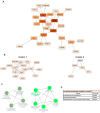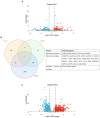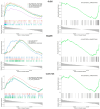Identification of Genes Linked to Meniscal Degeneration in Osteoarthritis: An In Silico Analysis
- PMID: 40724902
- PMCID: PMC12294481
- DOI: 10.3390/ijms26146651
Identification of Genes Linked to Meniscal Degeneration in Osteoarthritis: An In Silico Analysis
Abstract
Meniscal degradation is considered a driver of osteoarthritis (OA) progression, but the underlying mechanisms leading to age-related meniscus degeneration remain unknown. This study aimed to identify key genes and pathways involved in meniscal degradation through a computational analysis. Gene expression profiles were obtained from the Gene Expression Omnibus (GEO) database. Differential expression gene (DEG) analysis was performed using DESeq2 accompanied by functional enrichment analysis, protein-protein interaction (PPI) and clustering analysis. Additionally, gene set enrichment analysis (GSEA) was performed. A total of 85 mRNAs (DEMs) and 8 long non-coding RNAs (DE LncRNAs) were found to be differentially expressed in OA meniscus tissues. Among 85 DEMs, 12 genes were found to be known OA-related genes, whereas 15 genes acted as transcription regulators, including RUNX2 and TBX4, which were identified as effector genes for OA. Enrichment analysis revealed the implication of DEMs in cartilage-degradation-related processes, including inflammatory pathways, lipid metabolism, extracellular matrix organization and superoxide/nitric oxide metabolic processes. Target genes of DE lncRNAs were found to be involved in chondrocyte differentiation and pathways related to cartilage degradation. A comparative analysis of meniscus, synovium and cartilage datasets identified three genes (GJB2, PAQR5 and CLEC12A) as being differentially expressed across all three OA-affected tissues, which were implicated in inflammatory and cholesterol metabolism processes. Our results support that shared mechanisms lead to meniscal and cartilage degradation during OA progression, providing further insights into the processes underlying OA pathogenesis and potential therapeutic targets for knee OA.
Keywords: in silico analysis; meniscus; osteoarthritis; transcriptome.
Conflict of interest statement
The authors declare no conflicts of interest.
Figures






Similar articles
-
Identification of shared key genes and pathways in osteoarthritis and sarcopenia patients based on bioinformatics analysis.Zhong Nan Da Xue Xue Bao Yi Xue Ban. 2025 Mar 28;50(3):430-446. doi: 10.11817/j.issn.1672-7347.2025.240669. Zhong Nan Da Xue Xue Bao Yi Xue Ban. 2025. PMID: 40628511 Chinese, English.
-
Identifying pyroptosis- and inflammation-related genes in spinal cord injury based on bioinformatics analysis.Sci Rep. 2025 Jul 14;15(1):25424. doi: 10.1038/s41598-025-10541-w. Sci Rep. 2025. PMID: 40659785 Free PMC article.
-
Exploration of differential expression and biological significance of amino acid metabolism genes in osteoarthritis.Front Immunol. 2025 Jul 14;16:1588072. doi: 10.3389/fimmu.2025.1588072. eCollection 2025. Front Immunol. 2025. PMID: 40726988 Free PMC article.
-
Diacerein for osteoarthritis.Cochrane Database Syst Rev. 2014 Feb 10;2014(2):CD005117. doi: 10.1002/14651858.CD005117.pub3. Cochrane Database Syst Rev. 2014. PMID: 24515444 Free PMC article.
-
Hyaluronic acid and other conservative treatment options for osteoarthritis of the ankle.Cochrane Database Syst Rev. 2015 Oct 17;2015(10):CD010643. doi: 10.1002/14651858.CD010643.pub2. Cochrane Database Syst Rev. 2015. PMID: 26475434 Free PMC article.
References
MeSH terms
Substances
LinkOut - more resources
Full Text Sources
Medical

